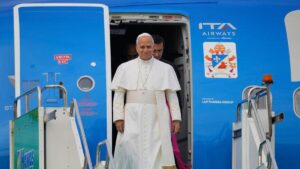
In a poignant moment at the onset of the COVID-19 pandemic, Cassy Appleton, a crew supervisor for Virgin Australia, delivered an emotional pre-landing safety message in March 2020. Her heartfelt farewell to the airline’s international operations, marked by tears, quickly went viral, epitomizing the uncertainty that gripped the aviation industry. Fast forward to today, Virgin Australia has made a remarkable comeback, now re-listed on the Australian Securities Exchange (ASX) and poised to challenge its rival, Qantas, once again.
The journey from that emotional speech to Virgin’s return to the ASX has been fraught with challenges. Shortly after Appleton’s address, Virgin Australia entered voluntary administration, was delisted from the ASX, and subsequently acquired by US-based private equity group Bain Capital. However, under new management and backed by a Middle Eastern aviation giant, Virgin has re-emerged as a formidable competitor in the Australian market.
Virgin Australia’s Strategic Re-entry
Virgin Australia’s return to the ASX marks a significant milestone in its recovery. The airline’s initial public offering (IPO) was made possible by several strategic decisions and favorable conditions. The appointment of a new chief executive, renewed investor interest, and the support of its largest union were pivotal in this process. Additionally, the backing of Qatar Airways, which now holds a stake in Virgin, played a crucial role.
Dave Emerson, who took over as Virgin’s chief executive in March, was instrumental in navigating the airline’s path back to the ASX. Emerson, a seasoned aviation consultant with Bain & Company, emphasized the importance of simplifying Virgin’s business model and focusing on areas where the airline could effectively compete.
The Role of Government and Union Dynamics
Virgin’s resurgence was not without its challenges. The Australian government’s decision to approve Qatar Airways’ participation in Virgin’s operations was a turning point. This approval allowed Virgin to enter a “wet-lease” agreement, enabling the airline to expand its flight offerings without the complexities of long-haul operations. This decision came after the government had previously denied Qatar Airways additional flights, citing “national interest” concerns, a move that led to a Senate inquiry.
The Transport Workers Union (TWU), representing a significant portion of Virgin’s workforce, played a crucial role in the airline’s recovery. The union welcomed Virgin’s decision to appoint Emerson as CEO, viewing it as a positive step towards a more collaborative relationship between management and employees. Emily McMillan, national assistant secretary of the TWU, expressed relief at Virgin’s leadership choices, which she believes have set the airline on a path to success.
Challenges and Opportunities Ahead
As Virgin Australia re-establishes itself in the market, it faces both challenges and opportunities. The airline’s strategy focuses on serving premium leisure, small and medium businesses, and value-minded corporate customers. This targeted approach aims to differentiate Virgin from Qantas, which dominates other segments of the market.
Emerson acknowledges the competitive nature of the aviation industry and the significant role Qantas plays. However, he is confident in Virgin’s ability to carve out its niche. “We have a lot of respect for Qantas,” Emerson stated, “but we believe our business model is well-suited to serve segments that are not as well addressed by our competitor.”
“We’re very proud of the product and service that we put out there. We provide strong competition and great value and service for Australian consumers.” – Dave Emerson, CEO of Virgin Australia
Virgin’s partnership with Qatar Airways is expected to bolster its international offerings, allowing the airline to “carefully re-enter” long-haul travel markets. The “wet-lease” agreement with Qatar provides Virgin with the necessary resources to expand its reach without the financial burden of owning and operating long-haul aircraft.
Looking Forward
Virgin Australia’s return to the ASX is a testament to its resilience and ability to adapt in the face of adversity. The airline’s strategic focus on simplifying operations and targeting specific market segments positions it well for future growth. As Virgin continues to rebuild its brand and strengthen its market position, the airline’s journey serves as a compelling example of recovery and innovation in the aviation industry.
With the support of its stakeholders and a clear vision for the future, Virgin Australia is poised to navigate the challenges ahead and seize new opportunities in the ever-evolving aviation landscape.






